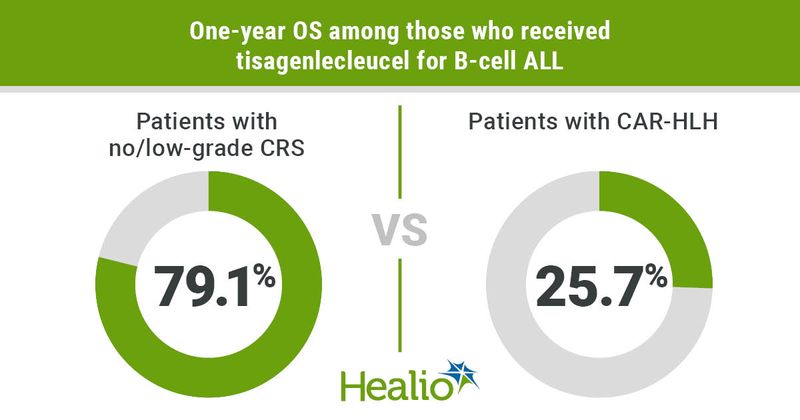CAR-associated hemophagocytic lymphohistiocytosis linked to poor outcomes in ALL
Younger patients who developed treatment-related hemophagocytic lymphohistiocytosis after tisagenlecleucel infusion for relapsed or refractory B-cell acute lymphoblastic leukemia had significantly poorer outcomes, according to study results.
Those who developed chimeric antigen receptor-associated hemophagocytic lymphohistiocytosis (CAR-HLH) after treatment with tisagenlecleucel (Kymriah, Novartis) achieved significantly shorter OS and RFS, findings from a retrospective analysis presented at Tandem Meetings | Transplantation & Cellular Therapy Meetings of ASTCT and CIBMTR showed.

Background
Cytokine release syndrome is the most significant treatment-related toxicity associated with CAR T-cell therapy.
A subset of patients who develop CRS with extreme hyperferritinemia and multiorgan dysfunction have been described as having a hyperinflammatory response known as CAR-HLH.
Significant clinical and biological overlap exist between CRS and HLH, according to Kevin O. McNerney, MD, MSc, hematologist-oncologist and bone marrow transplantation specialist at Johns Hopkins All Children’s Cancer & Blood Disorders Institute. A consensus definition of what qualifies as CAR-HLH is lacking, as are well-established prevention and management strategies, he said.
“The incidence of CAR-HLH varies by CAR T-cell product and disease,” McNerney said during a presentation.
Prior studies suggest incidence of CAR-HLH ranges from 14% to 36%, he added.
“[Our] study's aim was to determine outcomes and risk factors for CAR-HLH following commercial use of tisagenlecleucel in younger patients with B-cell ALL in a real-world setting,” McNerney said.
Methodology
McNerney and colleagues used retrospective data from the Pediatric Real World CAR Consortium (PRWCC), a group of 15 institutions that perform CAR-T for pediatric patients and collect data on patient outcomes.
The sample included 185 patients aged 26 years or younger who received tisagenlecleucel for relapsed or refractory B-cell ALL.
The PRWCC developed modified diagnostic criteria for CAR-associated HLH that included peak ferritin > 10,000 ng/mL and two or more of the following: renal toxicity, hepatic toxicity, hypoxemia, coagulopathy, and/or the presence of hemophagocytosis.
Researchers divided study subjects into three groups: those who developed CAR-HLH; those who developed high-grade CRS but not CAR-HLH; and those who did not develop high-grade CRS or CAR-HLH.
Investigators evaluated blood counts, inflammatory markers and disease burden before CAR-T infusion. Post-infusion variables included organ toxicity, coagulopathy, blood counts, inflammatory markers, CRS grade, neurotoxicity grade, relapse rate, time and cause of death, and infections.
Key findings
Twenty-six patients (14.1%) met PRWCC criteria for CAR-HLH. Thirteen patients (7%) had CAR-HLH and a ferritin level greater than 100,000 ng/mL.
Patients who developed CAR-HLH had significantly higher baseline bone marrow disease burden (54% vs. 3.1%; P < .0001), ferritin (median, 3,406 vs. 1,330 ng/mL; P = .0008), and C-reactive protein (4.9 vs. 0.9 mg/dL; P = .001), and significantly lower platelet count (36 vs. 121 × 109/L; P < .0001) and absolute neutrophil count (10 vs. 500 cells/µL; P < .0001) compared with those who did not.
Those with CAR-HLH had significantly higher risk of no treatment response at day 28 after infusion (OR = 4.36; P =.03), disease relapse (OR = 3.49; P = .004) and death (OR = 10.77; P < .0001).
Patients who developed CAR-HLH with a ferritin level greater than 100,000 ng/mL exhibited median OS of 85 days compared with 127 days among those who had CAR-HLH and ferritin levels greater than 10,000 ng/mL. Median OS had not been reached for patients who did not develop CAR-HLH.
Patients who did not experience high-grade CRS after tisagenlecleucel infusion appeared three times more likely than those who developed CAR-HLH to achieve 12-month OS (79.1% vs. 25.7%).
Likewise, those who did not develop high-grade CRS after treatment appeared considerably more likely to achieve 12-month RFS (57.9% vs. 4.7%).
Researchers reported a mortality rate of 76% among patients who had CAR-HLH compared with 20% for all patients in the study.
Nearly two-thirds (63.6%) of patients with CAR-HLH developed an infection within 28 days of CAR T-cell infusion compared with 17.6% of those who had high-grade CRS, and 13.9% for those with no/low-grade CRS and no CAR-HLH.
Clinical implications
The incidence of CAR-HLH in this real-world analysis appeared consistent with that observed in previous studies using CD19-directed 4-1BB CAR T cells, McNerney said.
The results suggest that preinfusion characteristics — such as high bone marrow disease burden, inflammation and cytopenias — are associated with CAR-HLH, in addition to post-infusion infections, neutropenia and thrombocytopenia, he added.
The PRWCC will next aim to develop and validate a predictive model for CAR-HLH, as well as work with ASTCT to establish a consensus definition for the condition, McNerney said.
"This is a likely underreported entity in clinical practice that results in significantly worse overall and relapse-free survival,” he said. “CAR-HLH represents a group of high-risk patients whose outcomes merit intensive investigation."

